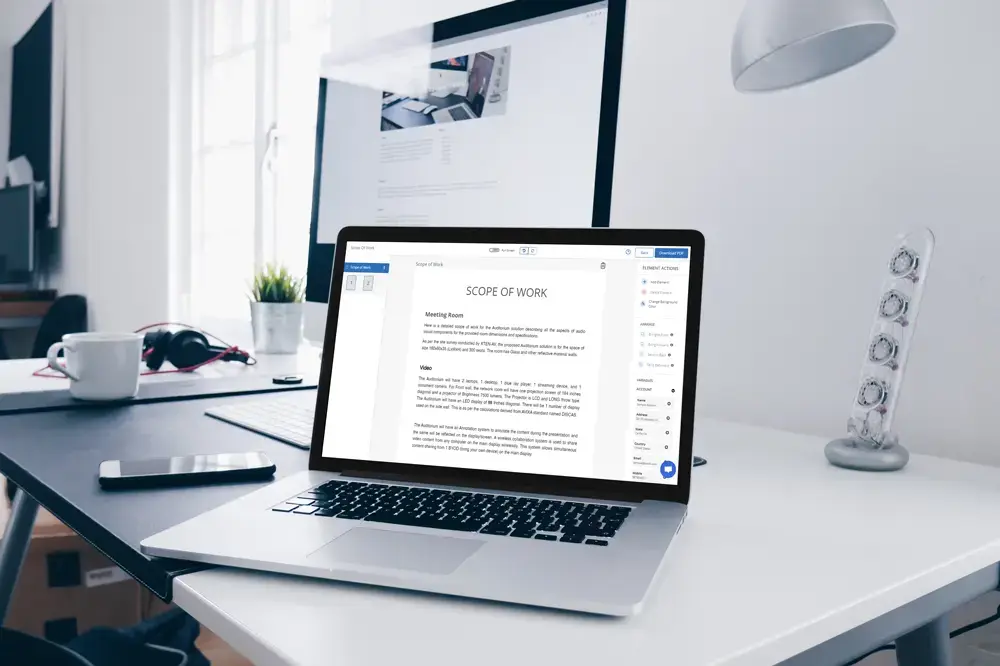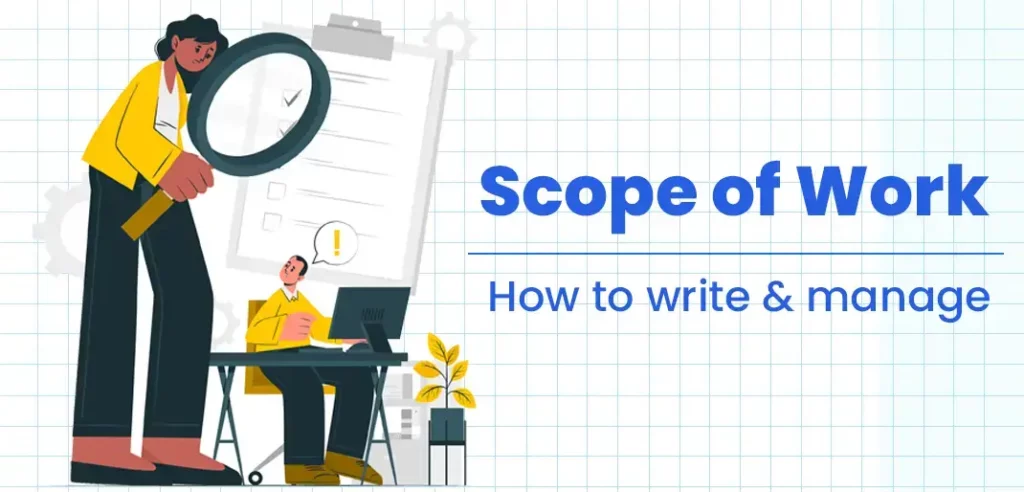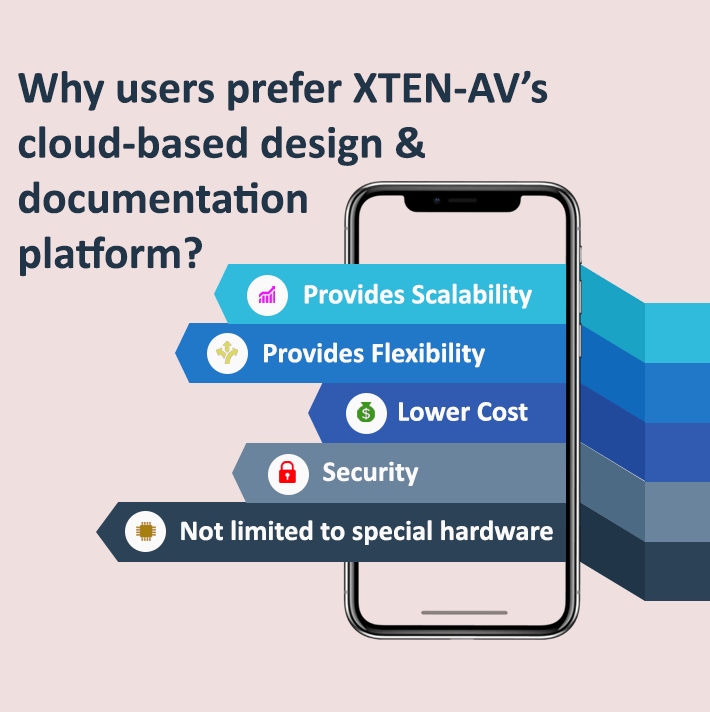How To Write and Manage Scope of Work (SOW) - Best Practices, Mistakes To Avoid, and Challenges
Let’s explore the world of AV and delve into a concept called the “Scope of Work.” Simply put the AV Scope of Work acts as a blueprint that outlines all the details of an AV project leaving no room for confusion. It precisely defines what needs to be accomplished from installing equipment to establishing connections.
Imagine you’re planning a home theater system. The Scope of Work would specify the types of speakers, their placement, and how they connect to the TV. Have you ever considered the steps required for setting up an AV system at home or work? Well, if your answer was no then you’re in luck! This blog is a guide that explains everything, about the Scope of Work and how to create a document that precisely captures it.
What Is a Scope of Work?
Let’s get a deep understanding of what the scope of work is. You can imagine it to be a roadmap for your project. It’s like a to-do list. Here you will make a list of milestones and assign it to people and check it whenever they are complete.
Ok sounds complex? Let’s break it down a bit. The first thing a scope of work mentions is what the project is about in detail. What do we want to achieve with that, after the analysis breaks it into small easily manageable tasks.
Next up, it mentions who’s responsible for what. Like, who’s in charge of designing, who’s doing the building, and who’s making sure everything is safe. Have you ever been in charge of something cool? Then, it talks about when things need to happen. Do you like making schedules? This part helps everyone stay on track. And finally, it sets the standards. What does success look like? How do we know when we’ve done a great job?
So, what’s your take on it? Can you think of a project you’d like to plan? Remember, it’s like making a super-detailed to-do list!
What Should Be Included in a Scope of Work Document?
The process of creating a scope of work document can be pretty hectic, as it involves getting in touch with the project manager, the stakeholders, and all the other parties involved. So here’s how we make it easy. Just follow the below pointers and you’ll be surprised with the results.
Deliverables
One of the elements that must be included in a Statement of Work (SOW) document is the list of project deliverables. These are the things that need to be created, accomplished or provided. For instance, if the project involves installing a video wall, some examples of deliverables could be acquiring the resources for the devices. Conducting a thorough analysis of suitable locations.
Timeline
This is simply you are creating a delayed calendar for each and every task. When to start, when to end, and everything in between. This also makes it easier for you to know if the project is going as targeted or delayed. Creating a timeline is a great help to each and every member involved in the project.
Milestones
Milestones are checkpoints for any project, it marks the progress of the timeline you created in the previous step. You can keep a tap if things are going as planned, just in case things are not going as planned then you can buy yourself time to prepare and alter the further tasks accordingly.
Report
Finally, including a report in your SOW is also really important. It gives an overview of the project, the speed, accuracy of work, and everything else. You can imagine it to be a progress card of your performance, but you will only get the report card at the end of the project.
Why Is It Important to Write a Scope of Work?
Now that we’ve understood what exactly the SOW is, it’s better to know how it facilitates your work. So, here are some basic pointers about why it is important to write a scope of work document:
Clear Expectations
A scope of Work (SoW) plays a role in any project by setting detailed expectations, for all involved parties. It outlines the objectives to be achieved, assigns responsibilities for each task and establishes the standards that must be met. This level of clarity helps avoid misunderstandings and ensures everyone is on the same page.
Avoids Scope Creep
Additionally a SoW acts as a measure against scope creep, which refers to additions of work or tasks to a project. With a defined SoW in place, any proposed changes can be evaluated against the agreement preventing unnecessary expansions that may cause delays and budget overruns.
Budget Control
Moreover, a crafted SoW enables estimation and control of project costs. By detailing deliverables and tasks, it facilitates precise budgeting. This efficiency in resource allocation helps maintain constraints throughout the project duration.
Timeline Management
The SoW also includes a project timeline that outlines deadlines for each task or phase. This aids in deadline management. Ensures that the project progresses in an organized and timely manner. Furthermore, it allows the identification of delays so that corrective action can be taken promptly.
Quality Assurance
By specifying quality standards and expectations within the SoW it guarantees that all work meets desired levels of excellence. It is essential to ensure the completion of a project that meets or surpasses the clients’ expectations.
Legal Protection
In case of any disputes or disagreements, a well-documented SoW serves as a legal document that outlines the agreed-upon terms and conditions of the project. It provides a reference point for resolving conflicts and helps protect the interests of all parties involved.
AV Statement of Work vs. Scope of Work
An Audio Visual Statement of Work (AV SOW) and Scope of Work (AV SoW) are both documents in AV projects. They serve distinct purposes:
AV Scope of Work
The AV Scope of Work outlines the specific tasks, activities, and deliverables related to the audio-visual aspects of a project. It establishes the boundaries and extent of the AV-related work by specifying what needs to be installed, integrated or implemented.
Key elements included in an AV Scope of Work involve specifying the types of AV equipment to be used, their placement, wiring requirements, integration with systems, and criteria for accepting the AV components.
AV Statement of Work
The AV Statement of Work is a document that formalizes the agreement between the client and the AV service provider or systems integrator. It provides information about the AV services to be provided including design, installation procedures, testing protocols, and commissioning processes.
The Statement of Work outline often includes aspects such as budget constraints, payment terms, and any additional costs associated with AV equipment or services. It also outlines communication protocols for reporting purposes as any legal or compliance considerations specific to the scope covered by audio-visual elements.
How to Write a Scope of Work?
Here’s the easiest 6-step solution to write a scope of work document.
- Start by giving an overview of the project and its objectives.
- Clearly outline the items or achievements that need to be produced or accomplished.
- Describe the tasks and activities required to achieve each deliverable.
- Provide a schedule that indicates the deadlines, for each task or milestone.
- Clearly define who is responsible, for each task or deliverable.
- Establish the criteria that must be met for each deliverable to be considered complete and satisfactory.
By following these steps you can ensure that the scope of the project is well defined allowing everyone involved to understand their roles, responsibilities, and expectations.
How To Write A Statement Of Work?
Here’s the easiest 6-step solution to write a statement of work document.
- Start with an introduction that provides an overview of the project, including its purpose and objectives.
- Clearly define the services or work that will be provided. Be specific about what’s included and what is not included.
- Outline the items, reports, or results that will be provided to the client upon project completion.
- Provide a schedule indicating when key deliverables or milestones are expected to be completed.
- Clearly outline the roles and responsibilities of both the client and the service provider. Specify who is responsible for each task.
- Include any terms, conditions, or legal requirements that both parties should be aware of. This may include payment terms, confidentiality clauses, and other relevant details.
By following these steps you’ll be able to create a comprehensive Statement of Work. It serves as an agreement between the client and service provider outlining expectations and deliverables for the project.
Scope of Work Tips / Best Practices
Here’s something that’ll help you go a long way in this journey: make sure to utilize them whenever you can. Smart work is always better than hard work, do you agree?
- Ensure clarity by being specific, about the project’s goals, tasks, and desired outcomes. To avoid any confusion, set expectations that match the resources and timeframe. Clearly define acceptance criteria for each deliverable to establish when it is considered complete.
- Document any assumptions, constraints, or limitations that could impact the project. Clearly outline roles and responsibilities for each task or deliverable to prevent any misunderstandings.
- Provide a timeline with milestones and deadlines for each phase of the project. Address how changes to the scope will be managed, including associated costs and timelines.
- Describe how progress will be reported and how communication will be handled throughout the project. Consider risks and outline plans for monitoring and mitigating them.
- Clearly state how the Statement of Work (SoW) will be reviewed, approved, and revised if necessary. Keep track of document revisions to ensure everyone is working with the up-to-date version.

Top 10 Common Mistakes to Avoid While Writing Scope of Work
There are many things that can go wrong while creating a SOW especially if you are new to this concept. So here we are bringing in some expertise to help you avoid some major mistakes:
- Lack of Clarity: When project objectives, deliverables, and expectations are not clearly and concisely communicated it can lead to misunderstandings.
- Overlooking Assumptions: Failing to document the assumptions made during project planning can cause issues when those assumptions prove to be incorrect.
- Omitting Key Stakeholders: It is important to involve all parties in discussions about the Statement of Work (SoW) to ensure alignment and satisfaction.
- Ignoring Scope Creep: Without a defined change management process uncontrolled changes in project scope can occur, resulting in delays and exceeding the budget.
- Vague Acceptance Criteria: Clear acceptance criteria for deliverables must be specified to avoid disputes regarding project completion.
- Skipping Risk Assessment: Identifying and addressing risks is crucial as it helps protect the project from problems.
- Inadequate Timeline Planning: Creating a project schedule with milestones is essential to avoid missed deadlines and delays.
- Ignoring Quality Standards: Setting quality expectations is vital as it ensures that the work meets or exceeds client satisfaction.
- Neglecting Legal Considerations: Addressing contractual aspects within the Statement of Work (SoW) helps prevent disputes and legal complications.
- Incomplete Review Process: Including a process for review and approval of the SoW ensures that errors or omissions are minimized.
Challenges Faced in Creating a Good SOW
Being in the process there are various things you will have to keep in mind, and we want to make that easier for you. So, here’s a list of challenges that you might face while creating a good SOW:
- Ensuring clarity and avoiding ambiguity, in the Statement of Work (SoW) can be quite challenging. It’s important to have a concise and precise SoW without any language or end statements to prevent misunderstandings and potential disputes during the project.
- Managing the expectations of stakeholders including clients, team members, and management can be a task. Aligning everyone’s goals and priorities is crucial for project execution.
- Preventing scope creep by defining boundaries for the project and implementing a change management process is essential. This helps maintain control over the project scope and ensures that it stays on track.
- Accurate estimation and planning are vital for creating a timeline and budget. Carefully considering all project elements while estimating helps avoid delays and cost overruns.
- Striking the balance between providing detail in the SoW while allowing flexibility during project execution can be tricky. Much rigidity can hinder creativity and problem solving whereas little structure can lead to chaos.
How to Manage Your Scope of Work with Project Management Software?
Introducing XTEN AV, a software solution for project management that aims to streamline and enhance the way you handle your Scope of Work (SoW). XTEN AV is a platform specifically designed for AV system designers and integrators making project management easier and more efficient.
With XTEN AV you can:
- Create Comprehensive SoWs: XTEN AV simplifies the process of creating well-structured SoWs. You can define project goals, tasks, milestones, and acceptance criteria in an organized manner.
- Foster Effective Collaboration: This software encourages collaboration among team members and stakeholders. Multiple users can work simultaneously on the SoW ensuring that all contributions are captured.
- Manage Changes: XTEN AV makes managing changes to the SoW effortless. You can easily track revisions, monitor scope adjustments and keep a record of all modifications to maintain control over the project scope.
- Accurately Estimate Resources: Proper resource estimation is XTEN AV assists you in allocating resources such as labor, materials, and equipment.
- Monitor Progress: Stay up to date with real-time monitoring and reporting features provided by XTEN AV. The software offers a dashboard that allows you to track project milestones, timelines as well as identify potential risks.
Experience enhanced project management with XTEN AV – your companion for handling Scope of Work tasks, in the AV industry.
Improve client communication by utilizing the platform to share project details and provide updates on progress. This will foster transparency and trust with clients.
AV Design Mastery + Winning Proposals = 10x Productivity!
- Automatic Cable Labeling & Styling
- 100+ Free Proposal Templates
- Upload & Create Floor Plans
- 1.5M Products from 5200 Brands
- AI-powered ‘Search Sense'
- Legally Binding Digital Signatures
Conclusion
Well, that’s it! A defined AV Scope of Work (SoW) is crucial, for any project whether it’s about setting up a conference room or a home entertainment system. It ensures everyone is aligned on the expectations and avoids any misunderstandings.
Can you recall a situation where having a defined SoW would have made an impact on an AV project you’ve been involved in? Remember, in the world of AV being clear and precise is crucial, and having a SoW is the tool to achieve that.
Frequently Asked Questions (FAQ's)
The project manager or a team lead, with input, from stakeholders typically develops the Scope of Work. They possess an understanding of the project’s objectives and requirements.
In project management, the Scope of Work is a document that outlines the tasks, activities, and deliverables necessary for the successful completion of the project. It establishes the boundaries of the project.
When creating a Scope of Work it is crucial to be precise, transparent, and concise. Include project objectives, tasks, timelines, roles, and acceptance criteria while avoiding any ambiguity to prevent misunderstandings.
The Scope of Work (SoW) is a section within the Statement of Work (SOW). It provides details on the aspects by specifying tasks, objectives, deliverables, and acceptance criteria unique to the project.
At the onset of a project, a Statement of Work (SOW) is employed to define expectations for all parties regarding scope and responsibilities. It serves as a document for planning and executing projects.
A Scope of Work (SoW) is vital in providing a roadmap for projects. It establishes expectations while preventing scope creep and ensuring everyone comprehends their roles, ultimately leading to outcomes.


